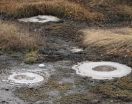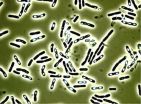INFORMATION:
Student helps to discover new pain relief delivery method
2015-04-01
(Press-News.org) A Chemistry undergraduate at the University of York has helped to develop a new drug release gel, which may help avoid some of the side effects of painkillers such as ibuprofen and naproxen.
In a final year project, MChem undergraduate student Edward Howe, working in Professor David Smith's research team in the Department of Chemistry at York looked for a way of eliminating the adverse side-effects associated pain-killing drugs, particularly in the stomach, and the problems, such as ulceration, this could cause patients.
Supervised by PhD student Babatunde Okesola, whose research is supported by The Wild Chemistry Scholars Fund, Edward hoped to create gels which could interact with drugs such as Naproxen, and release them at the slightly alkaline pH values found in the intestine rather than the acidic conditions in the stomach. His aim was to both protect the pain-killing drugs and help limit some of the side effects they can cause.
The researchers created a new gel, based on small molecules which self-assemble into nanofibers which could interact with a variety of anti-inflammatory, painkiller drugs, including iburofen and naproxen. The research is published in Chemical Communications.
Specific interactions between the gel nanofibres and the drugs meant that high loadings could be achieved, and more importantly, the release of the drug could be precisely controlled. The gels were able to release naproxen at pH 8 - the value found in the intestine, but not at lower pH values found elsewhere in the body.
Professor Smith said: "Although researchers have used gels before to try and improve the formulation of naproxen, this is the first time that a self-assembling system has been used for the job, with the advantages of directed interactions between the nanoscale delivery scaffold and the drug. As such, this is the first time that such precise control has been achieved."
Edward Howe said: "The research really fascinated me. The prospect of being involved in developing a method to reduce the pain of others filled me with great pride. Understanding the interactions between the gel and the painkillers was very interesting and improved my knowledge of supramolecular chemistry."
The next step for Professor Smith's team will involve stabilising the gel drug delivery systems in the very acidic, low pH, conditions found in the stomach so that they can transit safely to the intestine before delivering naproxen just where it is needed.
Professor Smith added: "Perhaps this is something that one of next year's undergraduate project students might solve. As a research-intensive institution, York is committed to its undergraduates carrying out cutting-edge research such as this."
ELSE PRESS RELEASES FROM THIS DATE:
Oral pain specialists treat complex health issues, according to new survey
2015-04-01
Andres Pinto, an orofacial pain and oral medicine specialist at Case Western Reserve University School of Dental Medicine, often feels like the doctor in the television series House, who solves medical mysteries each week.
Pinto is among about 700 facial pain and oral medicine specialists nationally who patients often turn to when their own doctors are unable to identify and treat complex and rare medical conditions. In fact, according to a new study Pinto conducted with input from fellow members of the American Academy of Oral Medicine (AAOM), patients see, on average, ...
Migrating immune cells promote nerve cell demise in the brain
2015-04-01
A small area in the midbrain known as the substantia nigra is the control center for all bodily movement. Increasing loss of dopamine-generating neurons in this part of the brain therefore leads to the main symptoms of Parkinson's disease - slowness of movement, rigidity and shaking.
In recent years, there has been increasing scientific evidence suggesting that inflammatory changes in the brain play a major role in Parkinson's. So far, it has been largely unclear whether this inflammation arises inside the brain itself or whether cells of the innate immune system that ...
Predicting chronic pain in whiplash injuries
2015-04-01
Large amount of fat in neck muscles predicts chronic pain, disability and PTSD
Will enable earlier treatment for whiplash victims
Fat indicates atrophy, shows the chronic pain is not psychological
Whiplash affects more than 4 million Americans annually
CHICAGO --- While most people should expect to fully recover from whiplash injuries within the first few months, about 25 percent have long-term pain and disability that lasts many months or years.
Using special MRI imaging, Northwestern Medicine scientists have identified, within the first one and two weeks ...
Lifting families out of poverty -- with dignity
2015-04-01
EAST LANSING, Mich. --- America's welfare state is quietly evolving from needs-based to an employment-based safety net that rewards working families and fuels dreams of a better life, indicates a new study led by a Michigan State University scholar.
The major reason: the little-known Earned Income Tax Credit, a $65 billion federal tax-relief program for poor, working families. The program has been expanded dramatically during the past 25 years, while cash welfare has been sharply curtailed.
Reporting in the April issue of the American Sociological Review, Jennifer Sykes ...
Story tips from the Department of Energy's Oak Ridge National Laboratory, April 2015
2015-04-01
ENVIRONMENT - Invertebrates' role in bioaccumulation ...
By studying fish and invertebrates in a creek with known mercury contamination, researchers are gaining a better understanding of the relationship between the toxin in the stream and bioaccumulation in organisms. While mercury concentrations in East Fork Poplar Creek in Oak Ridge, Tenn., have decreased significantly over the last 30 years, levels in tissue from fish have remained the same or increased. To understand why, a team led by Monica Poteat of Oak Ridge National Laboratory is examining the intricacies of ...
Study finds EITC bolsters recipients' self-respect while helping them financially
2015-04-01
WASHINGTON, DC, April 1, 2015 -- America's welfare state is quietly evolving from needs-based to an employment-based safety net that rewards working families and fuels dreams of a better life, indicates a new study led by a Michigan State University (MSU) scholar.
The major reason: the little-known Earned Income Tax Credit (EITC), a $65 billion federal tax-relief program for poor, working families. The program has been expanded dramatically during the past 25 years, while cash welfare has been sharply curtailed.
Reporting in the April issue of the American Sociological ...
Periodic puns, round 2: Chemistry jokes for April Fools' Day
2015-04-01
WASHINGTON, March 30, 2015 -- Last year, Reactions shook up the comedy world with a video featuring nothing but chemistry jokes. After overwhelming public acclaim, we're back for this April Fools' Day with round two, featuring a number of fan submissions. If you're looking for a laugh, or maybe a groan or two, check out the video here: https://youtu.be/QbxBsD_tDQw.
Subscribe to the series at http://bit.ly/ACSReactions, and follow us on Twitter @ACSreactions to be the first to see our latest videos.
INFORMATION:
The American Chemical Society is a nonprofit organization ...
Presence of heart pouch may explain strokes of unknown origin, UCI study finds
2015-04-01
Irvine, Calif., April 1, 2015 -- A pouchlike structure inside the heart's left atrial chamber in some people may explain strokes that otherwise lack an identifiable cause, according to UC Irvine School of Medicine researchers.
Dr. Mark Fisher, a professor of neurology and pathology & laboratory medicine, and colleagues evaluated 75 stroke patients at UC Irvine Medical Center to learn whether this left atrial septal pouch could be a potent source of stroke-causing blood clots.
Of the 23 patients who had experienced a stroke of undetermined origin (a "cryptogenic" stroke), ...
Life for specialists: In the poisonous breath of sleeping volcanos
2015-04-01
Jena (Germany) The "Villa trans lacum" at the eastern shore of the Laacher See (lake) in the volcanic part of the Eifel - a rural landscape in Germany - was a highly dangerous place. In the 19th century the Jesuit order bought the abbey Maria Laach and built a villa at the shore of the lake. This is where the friars congregated to pray far away from everyday life. But numerous Jesuits paid with their lives for the religious beliefs in the villa. Between 1864 and 1888 17 of them died in the building - literally in their sleep.
"The monks possibly died of carbon dioxide ...
A multi-faceted poison
2015-04-01
This news release is available in German.
The Bacillus cereus bacteria is one of the potential causes of food poisoning. Indeed, a recent study in Analytical and Bioanalytical Chemistry shows that this versatile pathogen produces 19 different variants of a poison that causes nausea and vomiting in human beings. This variety could explain why some cases are relatively benign and others can result in death.
Across Europe, the number of food poisoning cases caused by the Bacillus species is on the rise. While unpleasant, infections resulting from B. cereus are usually ...



